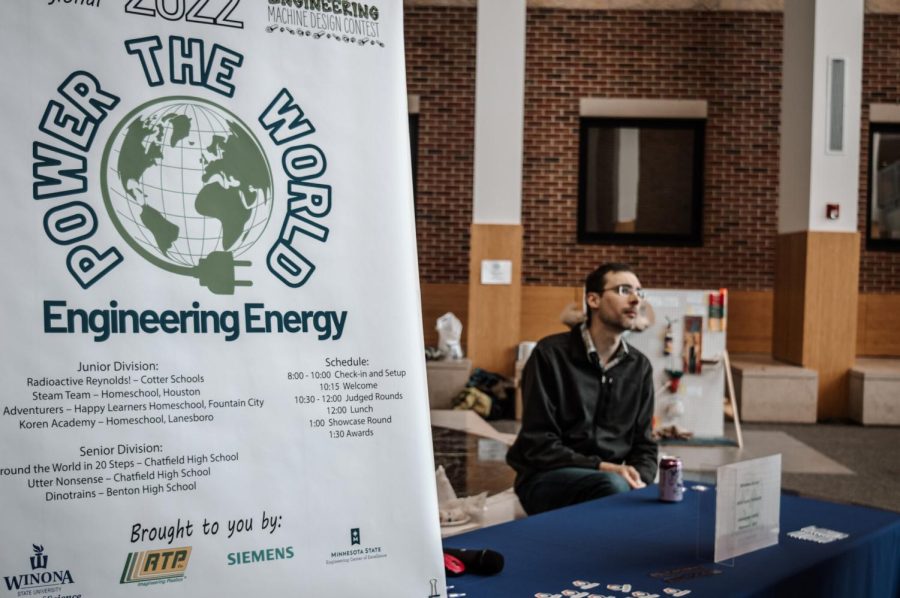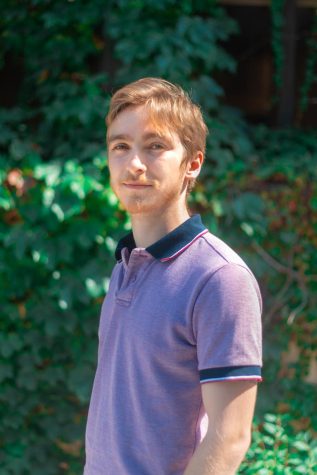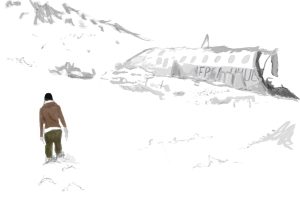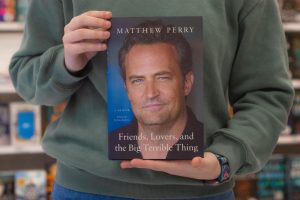Winona State hosts regional machine design contest for the first time
Winona State University hosted the Engineering Machine Design Contest for the first time on April 1, 2022 in the Science Laboratory Center (SLC) Atrium. Charla Miertschin, the dean for the college of science and engineering and one of the Engineering Machine Design Contest organizers, said Winona State plans to host the event again next year.
April 6, 2022
Winona State University hosted the Engineering Machine Design Contest for the first time on April 1, 2022 in the Science Laboratory Center (SLC) Atrium.
The contest was first started in 2018 by the Minnesota State Engineering Center of Excellence at Mankato State University with the goal of providing opportunities for students in grades five-12 to gain experience and interest in the engineering and STEM fields.
The competition featured seven teams of three-12 students each, split into four junior division teams (grades five-eight) from Houston, Lanesboro, local Winona Cotter Schools and Fountain City Wis. and three senior division teams (grades nine-12), one from Benton Wis. and two from Chatfield.
Each year the competition features a new theme that teams interpret and incorporate into their Rube Goldberg type machines. This year’s theme was “Power The World.” Click here to watch a video highlighting the event.
The students competing showed great creativity and diversity in their designs, each one being vastly different from another. One team went farm themed, decorating their machine accordingly and even wearing matching outfits consisting of cowboy hats, tucked in flannel shirts, belts with big buckles and blue jeans. Another team had their machine take a tour around the world displaying various world landmarks such as the Eiffel Tower and the Leaning Tower of Pisa; while another team took a trip through time. Each design brought something new and exciting and everyone was interested in seeing how they worked.

After teams would finish displaying their machine, they would go to watch and support other teams. There was a genuine sense of excitement and passion amid the participants.
In addition to creating a machine, teams had to also keep a journal and prepare a presentation. Lots of these presentations included puns and jokes, explanations of how the machine is supposed to work, their struggles in creating the design and the solutions they found to their problems along the way.
Senior division teams had more requirements for their machines. Some of these included a chemical reaction step, electric step, fluid power step and mechanical action step. Many of the machines were made from materials that a person could find at home: cardboard, peg boards, paper, popsicle sticks, wooden boards, doohickeys and doodads all painted and colored, glued and screwed to create a functional and visually appealing design.
More details about the Engineering Machine Design Contest can be found on their website at https:// engineering.mnsu.edu/engineering-machine-design-contest/.
Eric Kerr-Anderson, an assistant professor in the composite material engineering department at Winona State, explained what he thought the hardest and most crucial part of creating a Rube Goldberg style machine is.
“It’s like the Mouse Trap game; the idea is that you spend a lot of time on the transitions to make sure things effectively change over,” Kerr-Anderson said. “The ideal setup is that everything goes smoothly without any intervention, but as you probably know playing that game, there are a lot of times when you have to readjust things and make it go again.”
A group of three ninth grade girls from Chatfield–Ella, Rachel and Charlie–commented on what they learned while creating their farm themed machine, ‘Utter Nonsense.’
“[We learned] a lot of teamwork and collaboration and how to just make things work, to not just completely start over but to just make little changes until it does work,” Charlie said.
At the event there were several awards to be won. First there were the engraved wooden placement plaques, created by Johnathon Mauser, a professor in the Winona State chemistry department. There was also a Siemens award and an award designed and 3D printed by Winona State students in an upper level composite material engineering course.
Some of the special awards were the Theme Award, the Siemens Special Award, the Crub Award and the Everything but the Kitchen Sink Award. The judges for this competition consisted of retired professors, current faculty, industry leaders and one Winona State student.
Eric Paulsen, coach for the group of seventh grade boys from Cotter, commented why they chose to participate in the contest for the first time this year.
“It’s just fun to create and build and make messes and laugh and this was a great opportunity to do all those things,” Paulsen said. “A lot of these boys are interested in engineering or are participating in craft making and things of that nature so it seemed like a natural fit.”
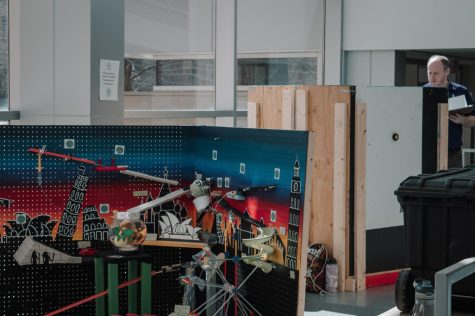
The event this year was sponsored by Siemens and RTP Company, which helped allow the Engineering Machine Design Contest to be free for teams to enter.
“It is up to the host location to determine the registration fee and because we got that sponsorship and we wanted to get people here,” Blandine Berthelot, an administrative assistant for the college of science and engineering, said. Paulsen also described what he felt his team learned.
“I think they are understanding, either through success or failure, the value of planning and thinking ahead, the struggle of working together and trying to share opinions and how to let their creative juices flow and dream big,” Paulsen said.
Paulsen and his team plan to participate again next year; they hope to create a zero-cost project with all recycled materials.
Kerr-Anderson also commented on what the main goal of this year’s event was.
“So, the idea is basically to give more opportunities for them to come and see we have an engineering program here, first off. Also any opportunities we can do to provide problem solving opportunities for students, that is what we are looking for,” Kerr-Anderson explained.
The top three placements in each division, which include Benton and the two Chatfield teams for the senior division, alongside Cotter, Houston and Lanesboro for the junior division, continue onto the championship at Minnesota State University-Mankato on April 22, 2022.
Charla Miertschin, the dean for the college of science and engineering and one of the Engineering Machine Design Contest organizers, said Winona State plans to host the event again next year.





























